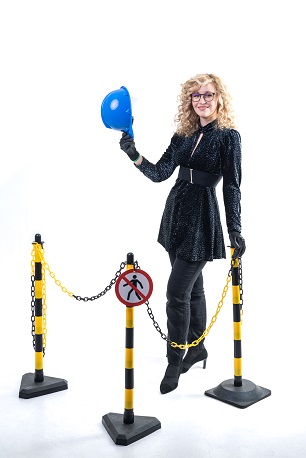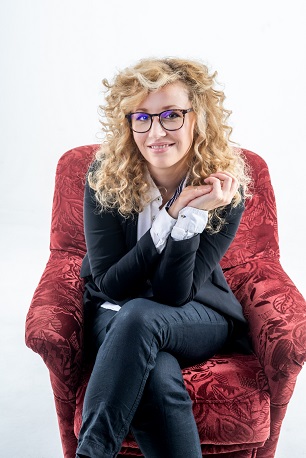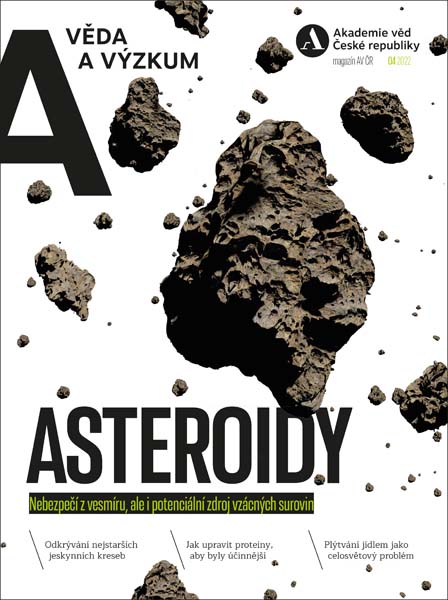
Kristýna Boušová: Engineering new proteins
17. 05. 2023
From an early age, she was fascinated by the microworld of cells and molecules. But she didn’t just want to observe it – she began to actively transform it. The new molecules from her lab can advance both medicine and environmental protection. “I am working on the strategic fusion of protein domains, which is a relatively new direction in protein chemistry and biochemistry,” says Kristýna Boušová from the Institute of Organic Chemistry and Biochemistry of the CAS.
Today, you’re a protein engineer, creating and improving proteins in your lab. Was there a direct path to this goal – did you enjoy science in high school?
I belong to the minority of scientists who didn’t attend a gymnasium [preparatory high school] but a technical school. Specifically, the Podskalská Secondary School of Food Technology, with a focus on chemistry and microbiology. Back then, I was particularly interested in the biological aspect of chemistry. For instance, I found the metabolic processes amazing. From about my second year onwards, I knew that I wanted to continue with biochemistry.
So for your university studies, you applied directly for a major in biochemistry?
I applied for two courses at the Faculty of Science at Charles University in Prague – one focused on environmental sciences, combining chemistry with nature conservation. The other was biochemistry. For a long time, I contemplated which one to choose, I was tempted by both, but eventually my fascination with biochemistry won out. Lately, I’ve been returning to environmental topics, so it has all come full circle.
Which of the two – biology and chemistry – interests you more, if it’s quantifiable?
Each holds a different significance for me. While chemistry is more of the technical aspect of the field, biology mainly inspires me. In my family we are all chemists – both my parents and my brother. But they are inorganic chemists, they focus on nanomaterials, which I consider a bit of a dry discipline. The biological aspect of chemistry connects me more with nature and its processes. I find it amazing to see what a cell looks like and all the processes occurring within.
Macrobiology didn’t appeal to you? Like animals or plants?
I like nature a lot, but I’ve never really examined it in depth. In high school, I dove straight into the biological microworld. Personally, the thing that fascinates me is the cell, whether from the perspective of a microorganism or its inner life, including signalling pathways and protein interactions. When you really dig into it, you find out how little we still know about all of it, that there is still so much to discover, and you realise what a tremendously interesting and complex world it is in itself.
|
RNDr. Kristýna Boušová, PhD, MBA From 2006 to 2012, she studied biochemistry at the Faculty of Science of Charles University in Prague. She completed her PhD studies at the Institute of Physiology of the CAS and after that, she transferred to the Institute of Organic Chemistry and Biochemistry of the CAS to the Group of Bioinformatics led by Jiří Vondrášek. Since 2017, she has been running her own experimental protein engineering lab. Since the end of 2019, she has also been working in her family’s start-up Art Carbon, which develops and offers water treatment technologies. In 2022, she received the Otto Wichterle Award.
|
From university, your path led you straight to a research institute. Unlike other young scientists, you haven’t yet travelled abroad for an extended fellowship, apart from a month at the Karolinska Institute in Sweden. Are you planning a trip abroad any time soon?
True, I haven’t really managed to go abroad yet. At the tail end of my PhD, I started working with the Group of Bioinformatics here at the Institute of Organic Chemistry and Biochemistry of the CAS, a team that deals with theoretical calculations of two-domain proteins. Its leader, Jiří Vondrášek, asked me if I could experimentally verify their calculations. Subsequently, he offered me the opportunity to start my own experimental team as part of the bioinformatics group.
That certainly must’ve been a big challenge for an early career researcher. So you preferred that to gaining experience abroad?
Exactly. I got the chance to start my own lab. For me, going abroad was a less appealing alternative at the time, because I probably would’ve been working on a research topic that wasn’t mine in a lab whose inner workings I couldn’t influence much. However, to answer the previous question: yes, I am planning to go abroad in the near future. After all, a researcher needs to gain new experiences and develop inspiration in the field after a while. We have a new Horizon Europe project starting in December, which allows for a placement abroad, both in Europe and, for instance, in South Africa, which I have a personal relationship with, so hopefully something will come of it.
We’ll get to South Africa in a minute. But first, let’s talk about bioinformatics. It is a rapidly developing field that makes it possible to process a huge amount of data available to biologists and chemists, such as DNA sequences. We’ve talked about inspiring biology, whereas bioinformatics is more about numbers. Where do these distant worlds converge for you?
They’re actually not distant at all. It’s in the field of protein chemistry that they complement each other perfectly. Bioinformatics works mainly with DNA and RNA biological data, which also provides information about protein sequences. Thanks to advanced and very fast methods of sequencing the genetic codes of organisms, the amount of this data is growing exponentially every year. Bioinformaticians perform analyses, calculations, and predictions using large amounts of data, and we, experimental chemists, are able to materialise their codes into real material that we then study further.
Yet these can be considered slightly different worlds – the world of mathematics, computations, algorithms vs the realm of experiments, test tubes, laboratories. Do the two ‘understand’ each other?
Our perspectives can be different, of course, but I find it a wonderful experience. The experimenter is typically used to being in the lab, handling test tubes, and operating the equipment. But when they also have the opportunity to be in direct contact with theorists, it allows them insight into the selection and analysis of biological data, which is a great benefit for the lab experiments themselves.
Do the bioinformaticians give you instructions on what to try out in an experiment, or does the collaboration work the other way around as well? For instance, you asking them to model what would happen if you added a particular molecule?
It works both ways, and sometimes it’s a sort of cycle. For instance, when the course of the experiment doesn’t quite match what the theory predicts. Then we go back to discussing with the bioinformaticians who, based on our results, adjust the input parameters for the calculations and create new model situations or new models of the molecules.
Your experimental lab is primarily involved in protein engineering, i.e., creating new proteins or improving them. Which proteins are these, specifically? Are we talking about the medical field or something else?
More specifically, it’s the strategic fusion of protein domains, which is a relatively new focus in protein chemistry and biochemistry. It’s utilised in medical research – in anti-cancer immunotherapy – where, for instance, the effect of antibodies against immune cells can be targeted. An illustrative example of protein engineering is the development of COVID-19 vaccines. In our lab, we work both at the basic research level and in the application sphere. In the first case, we are trying to shed light on what happens when we combine two protein molecules or parts of a protein molecule; for instance, we are interested in how the function of a given part of the molecule changes. By understanding such a mechanism, we are then just one step away from a design that can render the function of the molecule more efficient – this can reach up to thousands of times higher efficiency in terms of the activity of the molecule. Such improvements in protein function can help greatly advance the therapeutic effects of pharmaceuticals or save considerable costs in the biotechnology industry.
What about fusing molecules? I assume it’s not just a matter of throwing different molecules together and seeing what happens?
Not quite. It’s more complicated than that. We prepare a detailed design of the new molecule based on the analysis of the input biological data. We use molecular modelling to combine parts of the protein sequences. You could say that we cut out the part of the molecule that is the target of our study and then combine it with other parts of different proteins. For instance, we work with the HIV protease, whose sequence we modify at the amino acid level and then combine it with a suitable part of a protein from another molecule taken from an animal or plant cell. We combine the selected parts at the level of DNA, which we have synthesised, and then use the DNA sequence for protein expression in biological systems, such as bacteria or human cells.
How do you know which parts of the protein to splice and at which sites?
It requires a lot of preparation. First, you look at the computer model of the molecule to view the molecule in 3D and to identify the binding or catalytic site. With our experience, we can usually tell where we can afford to cut off a certain redundant part of the molecule and keep only the functional part which we want to examine. The protein domains that delimit the various functions of a molecule are fairly well described nowadays, but still remain an important subject of study. Researchers around the world are trying to understand how nature itself actually designs proteins. We do not yet understand this natural design. It is so complex that it cannot be explained without the help of modern AI and machine learning techniques.

We’re talking about protein domains, and we’ve also mentioned the term two-domain proteins. Let’s try to explain what that is and what the structure of a protein is.
We can say that a domain defines part of the function of a protein. Domains are often connected in a protein with the help of less ordered flexible sections that allow a certain level of freedom for the dynamics of the system as a whole. A protein is generally characterised by several structures. The primary structure is defined by a chain of consecutive amino acids, while at the secondary structure, side chains interact and join in different parts. The tertiary structure describes the 3D arrangement of the folded chain. It is the tertiary structure that is used to understand the functional or native state of the protein.
Could you give an example of a protein and its structures?
One nice example is ion channels, which I studied during my PhD. Specifically, it was transient receptor potential channels (TRP channels), located in the cell membrane. The channel itself is not functional unless it forms a tetramer, that is, until it is formed by four units of identical protein chains. It is only when these four units are combined that they give rise to a compact structure which forms a pore for ion transport at its centre.
Let’s move from theory to practice. In addition to basic research, you are also involved in applying the results in various fields. Can you mention anything in particular?
We are working in multiple areas, which I think is a big advantage of protein engineering. We can thus get into various fields, which is very rewarding. For instance, we are involved with the pharmaceutical field, where we are designing specific modifications to target cancer immunotherapies. Immunotherapeutic treatment is very expensive and can be effective, but it often has unpleasant side effects due to, among other things, non-specific targeting, i.e., when the substance also acts on non-cancerous cells.
So your job is to modify the substance so that it can better target the areas it is supposed to?
Yes, we only work with a part of the antibodies and try to modify them so that they have a higher specificity towards tumour cells. In other words, making them target exactly what they’re supposed to without compromising healthy cells. We have started working on this project with colleagues from Yale University, and we are now close to filing a patent and are looking for interested biotech and pharmaceutical companies to bid for the technology.
Can you mention any other project you are working on right now?
The next application of the research is also in the medical field and relates to applications in dental surgery, among others. By analysing a molecule present during the formation of tooth enamel, we’ve been able to characterise new peptides, which are short chains of proteins with antimicrobial activity. We worked on the project together with the University of Chemistry and Technology in Prague, and the joint output is a patent we’ve applied for.
What could your research findings help develop? Where could this antimicrobial activity come in handy?
Currently, we are collaborating with the University of Oslo in Norway and its associated dental clinic, where we are bonding these antimicrobial peptides to titanium material, which is a common basis for dental restorations. One of our PhD students recently spent two months in Norway developing the technology to bind the antimicrobial peptides directly to titanium denture samples and studying whether the activity of the peptides was retained.
How many people do you actually have in your team? Are there only PhD students or younger students as well?
I have three PhD students and one postdoc in my team, five of us in total, including myself. We don’t have anyone from abroad yet, but that will probably change in the near future, due to the upcoming European Horizon project I mentioned earlier.
Are students today interested in protein engineering?
Most of the people in my team who are doing protein engineering today came from the field of molecular biology, which is concerned primarily with DNA. Students often tell me that DNA can withstand anything and is much easier to work with, and that it was only when they started to work with proteins that they recognised a real challenge. It’s no easy feat, to keep a protein in its native state, that is, to keep it stable and fully functional so that we can get valid results with it. Compared to molecular biology, protein chemistry is more complex. So yes, there is interest from those students who want to try something a little more challenging and keep advancing their skills thanks to a relatively new branch of chemistry.

You must sometimes need to take a break from such demanding work. What do you enjoy besides chemistry and biology? What do you do to relax?
I compensate my time at work by being outdoors in nature a lot. I love hiking, camping... Before COVID-19 came along, I used to travel a lot as well, which could be combined with research quite well. Thanks to various conferences, I’ve had the chance to visit Japan, Australia, the United States, and Peru.
What about South Africa? You experienced that country too, but as a little girl. How did you end up living there? Your parents?
Yes, thanks to my parents. My dad studied nuclear chemistry at the University of Science and Technology in Prague, where he started his PhD. After the Velvet Revolution, my parents wanted to go abroad, so we went to Africa. We ended up spending two years there.
How old were you then and how do you remember your stay in the south of the African continent?
I was between three and five years old. I have a lot of memories from that time, though some of them are fragments. For example, I remember that in kindergarten we used to be given semolina porridge for lunch every day, never anything else. I can see it like it were yesterday – we had to sit up straight at the table, hands behind our backs behind our chairs, we weren’t allowed to move, and the teachers would walk by with enormous bowls full of porridge. At that moment our only wish was to get the portion of porridge with the most cocoa powder, because some of the bowls had porridge without cocoa. For me, life in Africa was one big adventure full of challenges and unique memories. I really wish I could go back there again.
We’ve mentioned your father, who is also a chemist, your brother is a chemist as well. You even run a family business together called Art Carbon, which offers carbon nanotube water purification technology. Do you help the company with research, or is your involvement conversely an activity that gives you a break from research?
It’s more of the latter. My brother Daniel and my dad deal with the development of the nanomaterial itself – the technology is primarily about inorganic chemistry, and I’m not an expert in that field. But my brother and I are constantly trying to think of new applications that we could work on together, and of course I’m invested in seeing them reach more into the biological sphere.
Can you give an example? In what area are you helping out your brother?
For instance, it would be possible to use fusion proteins designed to react to certain substances that nowadays dangerously pollute our environment. For instance, there is a big problem with so-called PFAS, which are polyfluoroalkyl substances. They are abundant in water and soil and have a strong negative effect on human health – it has already been proven they cause cancer and infertility. My brother and I applied for a grant from the Czech Science Foundation focusing this very issue.
Is your MBA degree, which you earned last year, also related to your active involvement in the family company?
No, it initially didn’t have anything to do with the company at all. When I got the chance to set up a new lab and my own working group, I had no experience in managing and coordinating a team of people, so I wanted to broaden my education in management and leadership. I went on to study innovation management, which ended up being a good fit for both areas, research and the company alike.
During the interview, we mentioned the large international Horizon Europe project that you are launching in December [2022]. What will it involve?
With this new project, I’m returning to the environmental themes that I gravitated towards during my university studies. Among other things, we will have the opportunity to design and improve new enzymes suitable for degrading plastics in the oceans. We will be working with thousands of new protein sequences that have been collected from global oceans over decades by the Tara schooner for the Tara Oceans research expedition. Our Group of Bioinformatics has joined the international BlueRemediomics consortium, which is directly linked to the TaraOcean Foundation project. This is very inspiring for all of us, and we are delighted to be able to make at least a small contribution to the recovery of our devastated planet.
The interview (in Czech) came out in the 4/2022 issue of the A / Magazine of the CAS.
Prepared by: Leona Matušková, Division of External Relations, CAO of the CAS
Translated by: Tereza Novická, Division of External Relations, CAO of the CAS
Photo: Jana Plavec, Division of External Relations, CAO of the CAS
Read also
- A trapped state: The pandemic impact on public attitudes, trust, and behavior
- Aerial archaeology: Tracing the footsteps of our ancestors from the sky
- Archaeologists uncover ancient finds along Prague Ring Road
- Our microbiome largely depends on what we eat, says microbiologist Michal Kraus
- The ABCs of writing: Why did its invention mark a turning point for humankind?
- We learn, remember, forget… What can memory actually do? And can we outsmart it?
- New Center for Electron Microscopy in Brno opens its doors to global science
- The hidden lives of waste: What can we learn from waste workers and pickers?
- A unique lab is hidden right beneath Prague’s Vítkov Hill
- Renewables are a strategic investment in European security, scientists say
The Czech Academy of Sciences (the CAS)
The mission of the CAS
The primary mission of the CAS is to conduct research in a broad spectrum of natural, technical and social sciences as well as humanities. This research aims to advance progress of scientific knowledge at the international level, considering, however, the specific needs of the Czech society and the national culture.
President of the CAS
Prof. Eva Zažímalová has started her second term of office in May 2021. She is a respected scientist, and a Professor of Plant Anatomy and Physiology.
She is also a part of GCSA of the EU.

